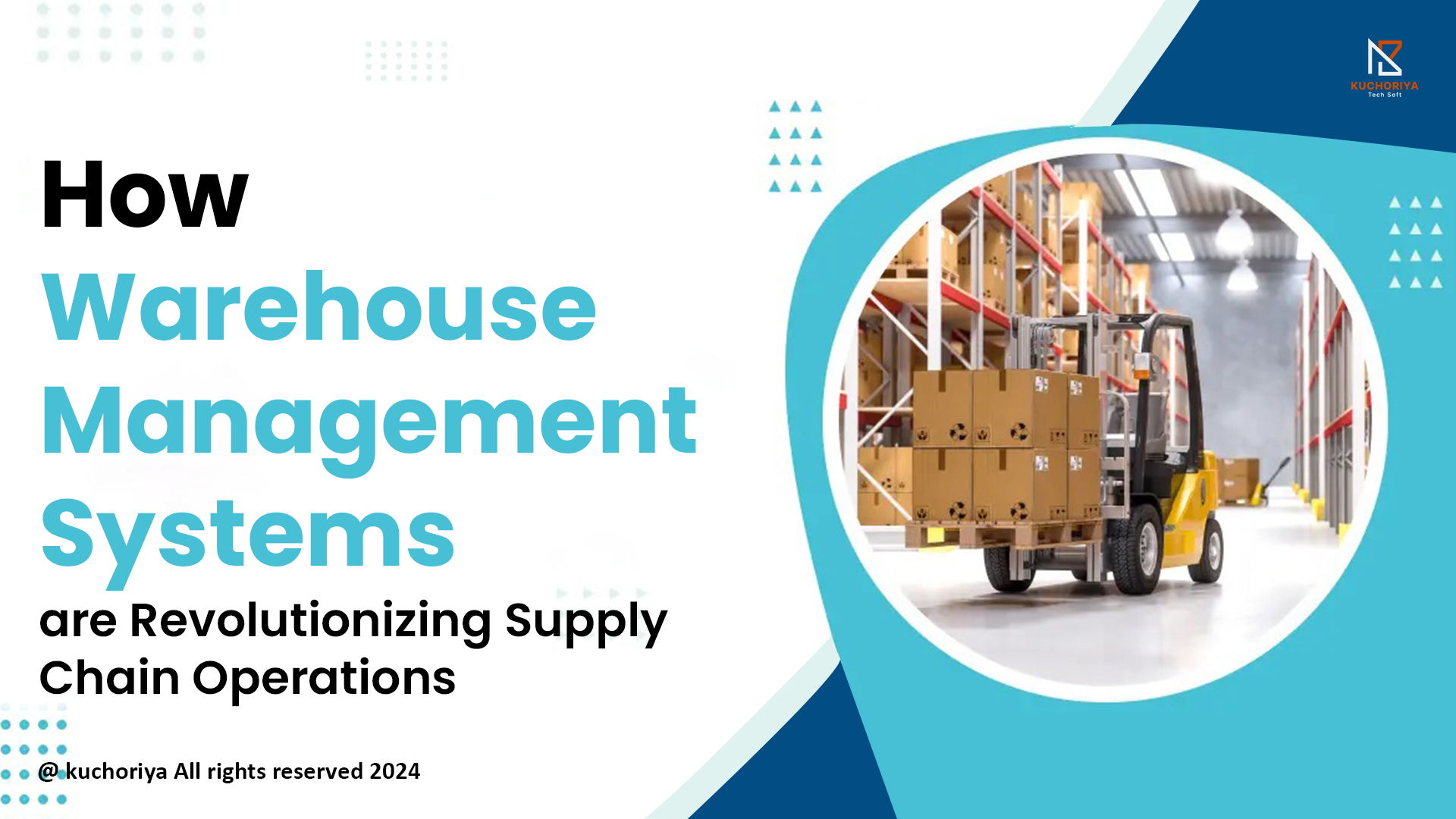International trade is based on supply chains, and the success of these supply chains depends on effective warehouse management. Supply chains are being completely transformed as 2024 approaches thanks to Warehouse Management Systems (WMS). The supply chain's vital component, warehouses, is being driven by these systems to increase productivity, accuracy, and efficiency.
Optimizing and streamlining warehouse operations is the goal of a sophisticated software program called a warehouse management system (WMS). A WMS makes warehouse resource management more effective, improves order accuracy, and increases overall productivity by giving real-time visibility into inventory levels, locations, and workflows.
Key Functions of a WMS
Inventory Management:
Tracking and Control: Until it is shipped out, inventory is tracked by a WMS from the time it enters the warehouse. To ensure accurate and current inventory records, this involves tracking stock levels, locations, and movements in real time.
Cycle Counting: Without interfering with daily operations, it facilitates routine cycle counting to confirm inventory accuracy.
Order Management:
Picking and Packing: By guiding employees along the most effective routes and techniques, the system speeds up and minimizes errors during the picking and packing process.
Shipping: A WMS creates shipping labels, keeps track of shipments, and makes sure that orders are filled accurately and on schedule.
Labor Management:
Task Assignment: The right people are performing the right jobs at the right times when tasks are assigned to warehouse employees based on their roles and skills.
Performance monitoring: Tracks and evaluates employee output, offering information about output and pinpointing areas in need of development.
Warehouse Layout Optimization:
Space Utilization: maximizes the use of warehouse space by figuring out where to store various kinds of goods depending on their attributes and demand trends.
Layout planning: Helps create effective warehouse layouts that reduce travel times and improve productivity.
Reporting and Analytics:
Operational Insights: Produces comprehensive reports and analyses on a range of warehouse operations topics, including labor productivity, order fulfillment times, and inventory levels.
Decisions Driven by Data: gives managers the knowledge they need to plan for future needs, enhance procedures, and make well-informed decisions.
Standalone WMS:
- Independent Systems: functions without interference from other software programs and is limited to warehouse management tasks.
- Ideal for Warehouses of Small to Medium Size: Suitable for smaller operations with less need for complex system integration.
Integrated WMS:
- Part of Larger Systems: incorporated into more comprehensive Supply Chain Management (SCM) or Enterprise Resource Planning (ERP) systems.
- Greatest for Big Businesses: Ideal for larger companies that require smooth integration with other business operations like distribution, manufacturing, and procurement.
Cloud-Based WMS:
- Hosted in the Cloud: Scalability, flexibility, and reduced upfront costs are provided by this internet-accessible product.
- Top Choice for Expanding Companies: Ideal for businesses who would rather avoid making an investment in on-premises infrastructure but still need to expand operations rapidly.
On-Premises WMS:
- Installed Locally: installed and maintained internally on the business's servers.
- Optimal for Big Businesses with IT Departments: Ideal for companies with the IT resources and infrastructure needed to administer and maintain the system.
Benefits of Implementing a WMS
- Increased Efficiency: A WMS decreases manual labor, expedites order fulfillment, and minimizes errors by automating and optimizing warehouse processes.
- Enhanced Accuracy of Inventory: The likelihood of stockouts and overstocking is decreased by regular cycle counting and real-time tracking, which guarantee accurate inventory records at all times.
- Enhanced Customer Satisfaction: Timely deliveries and happy customers are the results of processing orders more quickly and accurately.
- Cost savings: Over time, substantial cost savings are largely attributable to the efficient use of warehouse space, lower labor costs, and fewer inventory losses.
- Scalability: Without requiring a large additional investment, a WMS can grow with your business, adapting to increased volumes and changing needs.
Warehouse Management Systems (WMS) offer comprehensive solutions for managing warehouse activities, which are essential for optimizing supply chain operations. This is how they function:
Inventory Management
Exact inventory tracking and management are made possible by a WMS. The system logs each item that enters or exits the warehouse using barcode or RFID scanning. Insights into inventory turnover rates are also provided by this real-time tracking, which also helps to maintain accurate inventory levels and avoids stockouts or overstocking.
Order Fulfillment
Picking, packing, and shipping are all automated by the system, which expedites the order fulfillment process. Integration with ERP systems or e-commerce platforms allows for the receipt of orders. Next, the WMS makes picking lists, arranges the warehouse's picking routes optimally, and makes sure the right things are picked and packed quickly.
Space Utilization
By carefully arranging items according to their demand and turnover rates, WMS maximizes warehouse space. In order to optimize space utilization, the system rearranges current inventory and suggests storage locations for incoming goods. As a result, finding and retrieving items takes less time and effort, increasing warehouse productivity.
Labor Management
Effective labor management is aided by a WMS, which offers comprehensive insights into workforce activities. It keeps track of worker productivity, distributes work according to availability and skill levels, and evaluates output. This guarantees the best possible use of the labor force, cutting down on idle time and boosting productivity.
Reporting and Analytics
Strong reporting and analytics features are provided by a WMS. It produces reports on labor productivity, order fulfillment rates, inventory levels, and other topics. Warehouse managers can use these insights to identify areas for improvement, make data-driven decisions, and put strategies into place to improve operational efficiency.
Integration with Other Systems
Integration of a WMS with other systems, such as CRM, Transportation Management Systems (TMS), and Enterprise Resource Planning (ERP), is necessary to guarantee smooth operations. Through improved coordination and a decrease in errors, this integration makes it easier for information to move between various supply chain components.
Real-Time Visibility
Instantaneous visibility into warehouse operations is possible with a WMS. From a central dashboard, managers can keep an eye on workforce activities, order status, and inventory levels. Decision-making is improved, responsiveness to demand fluctuations is improved, and timely order fulfillment is ensured by this real-time visibility.
Automation
One essential element of WMS is automation. Repeated operations like data entry, inventory updates, and order processing are automated by the system. Staff members can concentrate on more strategic tasks while operations are sped up and the possibility of human error is decreased.
The efficient operation of logistics and transportation processes depends on effective warehouse management. Businesses face a number of difficulties that affect productivity, accuracy, and overall performance when they operate without a warehouse management system (WMS). Without the use of WMS, the logistics and transportation sector faces the following major obstacles:
1. Inventory Inaccuracy
Keeping accurate inventory records is one of the main difficulties. Errors like misplaced items, inaccurate counts, and disparities between physical and recorded inventory can occur with manual tracking systems or simple spreadsheets. This results in stockouts, shortages of inventory, overstocking, and, eventually, disgruntled customers from deliveries that are delayed.
2. Poor Space Utilization
Warehouses may struggle with inefficient storage space use in the absence of a WMS. Subpar product placement may occur from a lack of organized storage plans and up-to-date inventory level data. In addition to raising operating expenses, this inefficiency makes it more difficult to adjust for seasonal variations or inventory growth.
3. Inefficient Order Fulfillment
Picking and order processing by hand take a lot of time and are prone to mistakes. Fulfillment procedures may be fragmented and ineffective in the absence of the automated workflows that a WMS offers. This results in longer order processing lead times, higher labor costs, and a higher likelihood of order errors or shipment problems.
4. Limited Visibility and Traceability
Without a WMS, tracking the movement of goods inside the warehouse and across the supply chain becomes difficult. Poor traceability stems from not having real-time access to order statuses, shipment tracking, and inventory levels. This creates challenges when it comes to handling shipment delays, promptly responding to customer inquiries, and reducing the risk of inventory shrinkage or theft.
5. Manual Reporting and Analytics
Businesses must collect and analyze data manually if they don't have access to automated reporting and analytics features offered by a WMS. Making well-informed decisions is hampered by this laborious and prone to error procedure. Potential for process optimization and strategic planning is restricted by a lack of actionable insights into warehouse operations and performance metrics.
6. Labor Inefficiency
To accomplish tasks like order picking, packing, and inventory counting, manual warehouse operations need more labor hours. As a result, labor expenses go up while worker productivity goes down overall. Businesses find it difficult to optimize warehouse staff productivity and effectiveness without the labor management tools and workflow optimizations provided by a WMS.
7. Compliance and Regulatory Challenges
Regulations and compliance standards pertaining to the logistics and transportation sector are numerous. It may be difficult for businesses to follow industry standards for inventory control, product handling, and safety procedures without the automated tracking and documentation features offered by a WMS. Operations in the supply chain may be disrupted, regulatory fines may result, and reputational harm may occur.
8. Scalability Issues
The complexity of manually managing warehouse operations rises as businesses expand and grow. Businesses might find it difficult to adjust to rising order volumes, broader product lines, or shifts in consumer demand without scalable systems and procedures backed by a WMS. This restricts scalability and makes it more difficult to take advantage of growth prospects.
9. Customer Service Impacts
Without a WMS, ineffective warehouse management techniques can directly affect the quality of customer service. Customers may become dissatisfied due to order processing delays, order fulfillment errors, and a lack of real-time shipment tracking. Unfavorable customer experiences can lead to missed business opportunities and harm a brand's reputation.
10. Competitive Disadvantage
Having an advantage over competitors in today's cutthroat market requires effective warehousing and logistics practices. Without a WMS, companies might find it difficult to compete with rivals who use cutting-edge technology to streamline their supply chain processes. This may lead to a decline in profitability, a loss of market share, and difficulties keeping clients.
1. SAP Extended Warehouse Management (EWM)
2. Oracle Warehouse Management Cloud
3. Manhattan Associates WMS
How It Works: Utilizes AI and machine learning for efficient inventory management and order fulfillment.
4. Infor CloudSuite WMS
5. Blue Yonder Warehouse Management
6. HighJump WMS
7. Fishbowl Warehouse
8. Tecsys WMS
9. Epicor WMS
How It Works: Enhances warehouse efficiency through real-time data and automation.
10. 3PL Central
A comprehensive procedure must be followed when implementing a warehouse management system (WMS) in the logistics and transportation sector to guarantee effective warehouse operations, simplified inventory management, and improved supply chain visibility. This is a thorough overview of the procedures needed to implement a WMS:
1. Needs Assessment and Planning
An extensive needs assessment is the first step towards putting a warehouse management system into place. Comprehending the existing warehouse operations, pinpointing issues, and establishing precise aims and objectives for the WMS installation are all necessary steps in this process. To ensure comprehensive requirements gathering, key stakeholders from various departments such as operations, IT, logistics, and inventory management should be involved in this phase.
2. Vendor Selection
The success of the implementation depends on selecting the best WMS software provider. Industry experience, solution scalability, ability to integrate with current systems (CRM, ERP), support services, and total cost of ownership are all important considerations for businesses to consider when evaluating vendors. To make an informed choice, ask for demonstrations, verify references, and go over case studies.
3. Customization and Configuration
The WMS software is customized and configured to meet the unique needs of the logistics and transportation operations after a vendor is chosen. Setting up user interfaces, creating workflows for the receiving, picking, packing, and shipping procedures, establishing inventory management rules, and integrating with other enterprise systems are some examples of what this might entail.
4. Data Migration
Transferring current data from spreadsheets or outdated systems to the new WMS is known as data migration, and it is an essential step. This contains data on past transactions, SKU specifics, customer and supplier information, and inventory records. In order to guarantee accuracy and completeness prior to migration, data cleansing and validation are carried out.
5. Implementation Planning and Testing
Thorough implementation planning is necessary to reduce the amount of time that warehouse operations are disrupted during the transition. It may be decided to implement the WMS gradually, launching a pilot program in a single warehouse section before extending its reach throughout the whole complex. System performance, integration with other business systems, and functionality are all rigorously tested. This covers performance testing as well as user acceptance testing (UAT), integration testing, and unit testing.
6. Training and Change Management
To guarantee that warehouse employees and other stakeholders are competent in utilizing the new WMS efficiently, extensive training programs are necessary. Troubleshooting, inventory management, order processing, data entry, reporting, and system navigation are all covered in training sessions. To address resistance to change, encourage user adoption, and facilitate a seamless transition to the new system, change management strategies are put into practice.
7. Go-Live and Post-Implementation Support
The warehouse operations switch over to the new system and the WMS is formally launched during the go-live phase. Any problems or difficulties that may develop after implementation are handled with ongoing monitoring and assistance. Assisting users, resolving technical problems, and enhancing system performance in response to operational and user input are all included in ongoing support.
8. Optimization and Continuous Improvement
To optimize the benefits of the WMS, continuous optimization and improvement initiatives are essential beyond the initial phase of implementation. In order to do this, key performance indicators (KPIs) including cycle times, labor productivity, order fulfillment rates, and inventory accuracy must be tracked. To meet changing business needs, market trends, and legal requirements, systems are regularly updated, improved, and refined.
Warehouse Management Systems (WMS) are essential instruments in the supply chain and logistics sectors, providing all-inclusive solutions to optimize productivity. These are the top five characteristics that demonstrate the value and capabilities of WMS:
1. Inventory Management
Strong inventory management features are a fundamental component of any WMS. Real-time visibility into inventory levels, locations, and movements within the warehouse is made possible by WMS. Accurate stock rotation and inventory accuracy are guaranteed by its tracking of stock quantities, batch numbers, and expiration dates. By optimizing warehouse space and increasing inventory turnover rates, this feature lowers the risk of stockouts, overstocking, and obsolete inventory.
2. Order Management and Fulfillment
WMS facilitates effective order management, guaranteeing prompt order processing and fulfillment. Order picking, packing, and shipping procedures are automated by WMS, which lowers errors and improves order accuracy. Order cycle times and customer satisfaction are increased as a result of its efficient order routing and prioritization. Order types handled by Advanced WMS include single-item, batch, and multi-location orders. It can also easily adjust to changing customer needs.
3. Warehouse Layout Optimization
Warehouse layout can be optimized with the help of WMS for effective workflow management and space utilization. Based on variables like picking paths, storage needs, and frequency of demand, it employs algorithms to find the ideal storage locations for various products. This feature ensures effective use of storage space, cuts down on pickers' travel time, and lessens traffic in busy areas. WMS increases productivity, lowers labor costs, and boosts overall operational efficiency through warehouse layout optimization.
4. Real-Time Reporting and Analytics
WMS offers extensive analytics and reporting features that give insights into warehouse operations and performance indicators. Key performance indicators (KPIs) including inventory turnover, order fulfillment rates, picking accuracy, and labor productivity are all produced in real-time by this tool. Managers can use these insights to identify bottlenecks, make data-driven decisions, and carry out initiatives for continuous improvement. Proactive decision-making, improved operational efficiency, and flexibility in response to shifting market demands are all made possible by real-time visibility into warehouse operations.
5. Integration with Other Systems
WMS must have integration capabilities in order to communicate with other business systems like CRM (Customer Relationship Management), TMS (Transportation Management System), and ERP (Enterprise Resource Planning) without any issues. Through integration, data accuracy and consistency are ensured throughout the supply chain by removing silos between various departments and systems. WMS integration facilitates end-to-end visibility from procurement to delivery and improves information flow and stakeholder collaboration. It helps with workflow automation, lowers errors in manual data entry, and allows for scalability as businesses expand.
For logistics and supply chain environments, Warehouse Management Systems (WMS) depend on a strong technology stack to provide smooth and effective operations. The following is a summary of the key technologies that make up the WMS tech stack:
1. Database Management Systems (DBMS)
DBMS serves as the foundational component of WMS, managing and organizing large volumes of warehouse data. Popular choices include:
SQL (Structured Query Language): utilized by relational databases to hold transactional information about orders, shipments, and inventory.
NoSQL databases: Ideal for managing document-oriented databases used to manage product catalogs and inventory snapshots, as well as unstructured or semi-structured data.
2. Cloud Infrastructure
Cloud computing forms the backbone of modern WMS, offering scalability, flexibility, and accessibility. Key cloud platforms include:
Amazon Web Services (AWS): scalable cloud storage and processing power to manage WMS tasks across several warehouses.
Microsoft Azure: Provides analytics, cloud-based storage solutions, and integration with other enterprise systems.
Google Cloud Platform (GCP): Well-known for its capacity for processing and storing data, it supports machine learning and real-time analytics applications within WMS.
3. Real-Time Data Processing
Real-time data processing is critical for WMS to ensure accurate inventory tracking, order management, and fulfillment. Technologies include:
Apache Kafka: enables event processing and real-time data streaming, guaranteeing prompt updates and notifications for inventory movements.
Apache Spark: Facilitates parallel analytics and data processing, enabling WMS features like demand forecasting and predictive analytics.
4. Application Programming Interfaces (APIs)
APIs enable seamless integration between WMS and other enterprise systems, third-party applications, and IoT devices. Commonly used APIs include:
RESTful APIs: enables data interchange, order processing, and shipment tracking communication between WMS and external applications.
SOAP-based APIs: allows for safe data transfer and compatibility between legacy systems and WMS.
5. IoT Devices and Sensors
IoT devices and sensors play a crucial role in WMS for real-time monitoring of inventory levels, environmental conditions, and equipment performance. Technologies include:
RFID (Radio-Frequency Identification): tracks the locations and movements of inventory inside the warehouse, improving stock management accuracy and visibility.
Barcode scanners: Facilitate quick data entry and capture for order picking, shipment verification, and inventory tracking.
GPS and Geolocation Services: gives access to real-time location information for transportation logistics tracking shipments and improving route planning.
6. Machine Learning and AI
Machine learning and AI algorithms enhance WMS capabilities by predicting demand patterns, optimizing warehouse layout, and automating decision-making processes. Technologies include:
Predictive Analytics: estimates inventory requirements, improves replenishment cycles, and lowers stockouts by analyzing past data.
Machine Vision: Automates quality control, item recognition, and inventory counting in warehouses using computer vision technology.
7. Mobile and Web Development Frameworks
Mobile and web applications are essential for providing real-time access to WMS functionalities on various devices. Frameworks include:
React: Front-end library for creating dashboards and user interfaces that are responsive for WMS apps.
Angular: Facilitates the smooth integration of WMS features across web platforms and modular development.
Flutter: permits the creation of mobile apps for multiple platforms, guaranteeing warehouse managers' and operators' consistent user experiences.
8. Security and Data Protection
Ensuring data security and compliance with industry regulations is crucial for WMS. Technologies include:
Encryption: protects sensitive data from unauthorized access by ensuring data transmission and storage are secure.
Identity and Access Management (IAM): Based on roles and responsibilities, IAM manages user permissions and limits access to vital WMS functions.
Security Information and Event Management (SIEM): keeps an eye on and examines WMS activity logs to quickly identify and address security incidents.
9. DevOps Tools
DevOps practices streamline WMS deployment, monitoring, and maintenance processes. Tools include:
Docker: WMS applications and dependencies are packaged into transportable containers using containerization technology.
Kubernetes: An orchestration tool for cloud environments that automates the deployment, scaling, and management of containerized applications.
10. Analytics and Reporting
Analytics and reporting tools provide insights into warehouse operations, performance metrics, and KPIs. Technologies include:
Tableau: Platform for data visualization that allows users to create interactive reports and dashboards to track trends and performance in WMS.
Power BI: Power BI is a business intelligence tool that helps with data-driven decision-making, predictive model generation, and warehouse data analysis.
For logistics and transportation companies looking to increase efficiency, optimize workflow, and boost customer satisfaction, purchasing a Warehouse Management System (WMS) is an important investment. Several factors influence the cost of implementing WMS software, such as the organization's size, the functionalities needed, the deployment model, and any additional customization requirements. The following provides a thorough analysis of the expenses related to WMS software:
Factors Influencing WMS Software Costs
- Size and Complexity of the Operation: The complexity and, consequently, the price of the WMS software are influenced by the size of warehouse operations, which includes the quantity of locations, SKUs (stock keeping units), and daily transactions.
- Deployment Model: Cloud-based or on-premises deployments are possible for WMS software. On-premises solutions could necessitate upfront investments in hardware and software, whereas cloud-based solutions usually involve subscription-based pricing models (monthly or yearly).
- Functionalities and Customization: Order processing, picking/packing, and inventory management are examples of basic WMS functions. Higher costs may be associated with additional features like RFID support, advanced analytics, and ERP system integration. Customization to fit particular business procedures raises the total cost as well.
- User Licenses: The amount that WMS software charges is frequently determined by how many named users or concurrent users use the system. More user licenses may be needed by larger companies or those with more shifts, which would raise the total cost.
- Integration Requirements: Development and maintenance costs may increase for integration with current enterprise systems like TMS (transportation management system), CRM (customer relationship management), or ERP (enterprise resource planning).
- Training and Support: Training warehouse employees and continuing technical support are included in implementation costs. Training makes sure the WMS is used effectively, and support services make sure there is little interruption to daily operations.
Typical Cost Breakdown
- License Fees: Depending on the vendor and deployment model, WMS software licenses can cost anywhere from thousands to hundreds of thousands of dollars. For small warehouses, cloud-based solutions can start as low as $1000 per month, while larger businesses may have to pay as much as $50,000 a year.
- Costs associated with implementation: These expenses cover data migration, software customization, and system integration. Depending on the deployment's complexity, this can account for anywhere between 20% and 50% of the total cost of the software license.
- Hardware Costs (for On-Premises): Servers, networking hardware, barcode scanners, and RFID readers are needed for on-premises deployments, which significantly increases the initial outlay of funds. Tens of thousands to hundreds of thousands of dollars may be involved.
- Subscription Fees (for cloud-based): Monthly or yearly subscription fees are normally assessed for cloud-based WMS solutions, either per user or per warehouse location. For a basic package, prices may begin at $1000 per month and go up depending on users and additional features.
- Support and Maintenance: In most cases, cloud-based solution subscription fees cover ongoing support and maintenance. These expenses can account for 10% to 20% of the annual software license fees for on-premises deployments.
Cost Considerations for Different Business Sizes
- Small Businesses: Depending on the number of users and features needed, cloud-based WMS solutions range in price from $1000 to $5000 per month for small warehouses with basic inventory management needs.
- Medium-Sized Businesses: The annual cost of comprehensive cloud-based WMS solutions, which include ERP system integration and customization, can range from $50,000 to $150,000 for medium-sized warehouses.
- Large Enterprises: Enterprise-level WMS solutions, which include robust support and scalability features, can cost more than $500,000 a year for large distribution centers handling complex operations and extensive inventory.
1. Industry Experience and Expertise
Seek out a software development firm that has a lot of experience creating WMS solutions that are especially suited to the transportation and logistics sector. They should be knowledgeable about the particular difficulties faced by the industry, have a track record of successful implementations, and be acquainted with the pertinent rules and guidelines.
2. Customization Capabilities
Assess the company's capacity to modify WMS solutions in accordance with your particular business needs. Your present operations and expansion goals should be supported by a flexible and scalable WMS that can easily integrate with your current ERP, CRM, and TMS systems as needed.
3. Technology Stack and Innovation
Examine the company's development frameworks and technology stack. Make sure they use cutting-edge technologies that enable advanced analytics, mobile compatibility, RFID integration, and real-time data processing. Innovation in WMS solutions has the potential to greatly improve decision-making and operational effectiveness.
4. Client References and Case Studies
To learn about the software development company's previous projects and client satisfaction rates, ask for case studies or client references. Reaching out to current clients can offer valuable perspectives on the responsiveness, caliber of support, and general project management competencies of the organization.
5. Scalability and Support
Select a WMS software development company that provides solutions that are scalable and can expand to accommodate your business's needs. To make sure the WMS continues to satisfy your changing needs over time, take into account their capacity to offer continuous support, upkeep, and updates.
6. User Interface and User Experience (UI/UX)
In order for warehouse workers to embrace and fully utilize the capabilities of the WMS, an intuitive and user-friendly interface is imperative. Examine the company's UI/UX design methodology to make sure it maximizes output and reduces the need for warehouse operators to receive training.
7. Implementation Methodology
Find out about the project management procedures and implementation methodology used by the organization. Ensuring timely delivery and minimizing disruptions to your daily operations during deployment can be achieved through a structured approach that includes clear milestones, regular communication, and transparent reporting.
8. Cost and Budget Considerations
Recognize the pricing structure, which includes setup fees, license fees, customization fees, and continuing support fees. While comparing quotes from various software development firms, take into account the WMS solutions' overall value and return on investment (ROI).
9. Security and Compliance
Make sure the WMS software development company complies with industry guidelines and best practices regarding data security, such as access controls, encryption, and data backups. Adherence to regulatory mandates like GDPR and HIPAA is of paramount importance, particularly when managing confidential customer and operational data.
10. Feedback and Reviews
Finally, look for reviews and comments from software review sites, online discussion boards, and colleagues in the industry. Views on the usability, performance, and dependability of the WMS solutions provided by various companies can be gained from the insights of other logistics and transportation specialists.
1. Industry-Specific Expertise
Creating specialized WMS solutions for the logistics and transportation industry is Kuchoriya TechSoft's area of expertise. With years of experience in the field, they are aware of the particular difficulties faced by logistics companies and provide tailored solutions to successfully address these difficulties.
2. Proven Track Record
The business has a track record of successfully completing WMS projects for clients in the transportation and logistics industries. They have put into place reliable and scalable solutions that raise customer satisfaction, lower costs, and increase operational efficiency across a number of supply chain segments.
3. Customization Capabilities
Kuchoriya TechSoft is an expert at offering WMS solutions that are easily customized to meet the unique requirements and operational procedures of logistics and transportation firms. Their development team works closely with customers to customize features like order fulfillment, warehouse optimization, inventory management, and real-time tracking to meet specific business needs.
4. Technology Expertise
The organization develops sophisticated WMS solutions by leveraging development frameworks and state-of-the-art technologies. This includes the ability to integrate with other systems, like CRM, TMS, and ERP, to guarantee smooth data transfer and all-encompassing supply chain management..
5. Scalability and Flexibility
The WMS solutions offered by Kuchoriya TechSoft are built to grow with your business. Without sacrificing performance, their systems can handle growing volumes, adding more warehouses, and changing operational needs whether you run a small logistics hub or a large distribution network.
6. Comprehensive Support and Maintenance
After implementation, they offer full support services, such as routine maintenance, troubleshooting help, and updates. By doing this, you can minimize downtime and interruptions to your supply chain operations and ensure that your WMS stays operational and optimized.
7. Customer-Centric Approach
Throughout the development and implementation stages, Kuchoriya TechSoft keeps lines of communication open and places a high priority on customer satisfaction. They pay attention to what customers have to say, take recommendations into consideration, and work hard to provide solutions that go above and beyond.
8. Cost-Effective Solutions
Their pricing strategy is open and competitive, and they provide affordable solutions that boost productivity, cut down on errors, and simplify procedures for logistics and warehouse management. These solutions yield substantial returns on investment.
9. Security and Compliance
In logistics and transportation operations, security is critical. Sensitive information is protected throughout the supply chain by Kuchoriya TechSoft's adherence to industry best practices and compliance standards, which guarantee data security, confidentiality, and regulatory compliance.
10. Positive Client Feedback
Finally, Kuchoriya TechSoft has garnered positive reviews and testimonials from satisfied clients in the logistics and transportation industry. Their commitment to excellence, technical expertise, and customer-centric approach make them a trusted partner for optimizing warehouse management systems.
Warehouse Management Systems (WMS) have improved inventory control, streamlined order fulfillment procedures, and optimized efficiency to completely transform supply chain operations. These systems use cutting-edge technology, such as automation and real-time data analytics, to increase productivity, lower expenses, and improve accuracy. Enhancing operational agility and offering strategic insights for well-informed decision-making, WMS can scale and adjust to changing business requirements. In the ever-changing world of supply chain management, companies can gain a competitive edge by incorporating WMS into their operations, which guarantees more efficient workflows, quicker order processing, and higher customer satisfaction.
Joining Kuchoriya TechSoft as a referral partner offers professionals a thrilling opportunity to work with a top software development company. Here's a thorough explanation of the reasons behind your consideration of becoming a Kuchoriya TechSoft referral partner:
Why Become a Kuchoriya TechSoft Referral Partner?
- Access to Cutting-edge Solutions: You have access to Kuchoriya TechSoft's entire portfolio of cutting-edge software development solutions as a referral partner. You can recommend premium services to your network with confidence, regardless of the technology innovations—AI, IoT, custom software development, or others.
- Profitable Incentives and Rewards: Receive enticing commissions and incentives for each successful recommendation. Kuchoriya TechSoft cherishes its collaborations and makes sure that partners in referrals receive just compensation for their contributions and hard work.
- Expertise and Reliability: With years of expertise and a track record of providing top-notch solutions all over the world, Kuchoriya TechSoft is a dependable partner in the tech sector. You can rely on our experience to handle the wide range of needs that clients from different industries have.
- Grow Your Network: You can grow your professional network by partnering with Kuchoriya TechSoft. Making connections with business leaders, prospective customers, and like-minded individuals will provide you the chance to collaborate and expand your company.
- Marketing and Sales Support: Get thorough marketing materials and sales support to help you properly market Kuchoriya TechSoft's offerings. We give you the resources and tools you need to improve your sales efforts and increase the number of opportunities for referrals.
- Modifiable Partnership Models: We provide modifiable partnership models that can be customized to your tastes and professional objectives. Regardless of your role as an agency, company, or individual consultant, we can tailor our partnership approach to meet your specific requirements.
Join Us as a Referral Partner Today!
In addition to providing access to profitable opportunities, partnering with Kuchoriya TechSoft places you in the company of a reputable software development leader. Whether your goals are to increase revenue, broaden your scope of services, or strengthen clientele, joining Kuchoriya TechSoft's referral network is a calculated move that will help both of you succeed in the fast-paced tech sector.
Question: What are the benefits of using a Warehouse Management System?
Ans.: WMS enhances inventory accuracy, improves order fulfillment, optimizes labor productivity, and provides valuable operational insights.
Question: How does a WMS integrate with existing systems?
Ans.: WMS integrates with systems like ERP and TMS using APIs and other integration tools to ensure seamless data flow and operational efficiency.
Question: What factors affect the cost of a WMS?
Ans.: Factors include feature complexity, customization, integration requirements, scalability, and ongoing maintenance and support.
Question: Why should I choose Kuchoriya TechSoft for WMS development?
Ans.: Kuchoriya TechSoft offers extensive experience, customized solutions, advanced technology integration, and comprehensive support, making it the ideal choice for WMS development in the logistics and transportation industry.
Question: How can I become a Kuchoriya TechSoft Referral Partner?
Ans.: Visit our website to register as a referral partner and start earning rewards by connecting businesses with our top-tier WMS solutions.


















